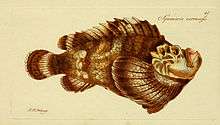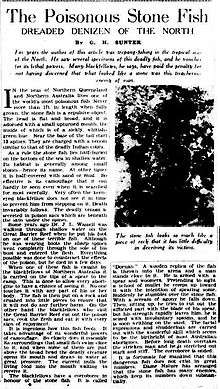Synanceia
Synanceia is a genus of fish of the family Synanceiidae, the stonefish, whose members are venomous, dangerous and even fatal to humans. They are the most venomous fish known.[1][2] They are found in the coastal regions of the Indo-Pacific.
| Synanceia | |
|---|---|
 | |
| Type species Synanceia verrucosa, 1801 illustration | |
| Scientific classification | |
| Kingdom: | Animalia |
| Phylum: | Chordata |
| Class: | Actinopterygii |
| Order: | Scorpaeniformes |
| Family: | Synanceiidae |
| Genus: | Synanceia Bloch and J. G. Schneider, 1801 |
Taxonomy
The type species of the genus is Synanceia verrucosa, which includes the species Synanceia horrida that Linnaeus described as Scorpaena. The misspelling Synanceja is regarded as a synonym for this genus.
Species

The following is a list of species in the genus:[3]
| Image | Scientific Name | Common Name | Distribution |
|---|---|---|---|
| Synanceia alula (Eschmeyer & Rama Rao, 1973) | Midget stonefish | northern Indian Ocean to the Solomon Islands | |
.jpg) | Synanceia horrida (Linnaeus, 1766) | Estuarine stonefish | India to China, the Philippines, Papua New Guinea and Australia, and is also recorded in Vanuatu |
| Synanceia nana (Eschmeyer & Rama Rao, 1973) | Red Sea stonefish | Red Sea and Persian Gulf | |
| Synanceia platyrhyncha (Bleeker, 1874) | Indonesia | ||
 | Synanceia verrucosa (Bloch and J. G. Schneider, 1801) | Stonefish | Red Sea and Indo-Pacific |
Habitat and characteristics
Synanceia are primarily marine, though some species are known to live in rivers. Its species have potent neurotoxins secreted from glands at the base of their needle-like dorsal fin spines which stick up when disturbed or threatened.[4] The vernacular name of the species, the stonefish, derives from its grey and mottled camouflage similar to the color of a stone.[5] Swimmers may not notice them and inadvertently step on them, triggering a sting. When the stonefish is disturbed, it may inject an amount of venom proportional to the amount of pressure applied to it.
A study published in 2018 reports that stonefish also have the ability to extend a sharp, specialized spine known as a lachrymal saber as an additional defense mechanism.[6][7]
The venom of Synanceia is potent and can result in cellular deterioration of the afflicted organism due to toxins that target cellular membranes.[8] The venom can also lower white blood cell count and lead to infection of the area even after appropriate treatment of the wound.[9]
Treatment of envenomation
Stonefish stings are extremely painful and potentially lethal.[10] The two most recommended treatments are the application of heat to the affected area, and antivenom. Hot water (at a temperature no higher than 45 °C (113 °F))[11] applied to the injured area has been found to denature stonefish venom, and causes minimal discomfort to the victim. Antivenom is used in more extreme cases. Vinegar is found on some Australian beaches as it is said to lessen the pain.[12]
Stonefish stings in Australia
The stonefish is one of the most venomous fish in the world[13] and stings can cause death if not treated. Most stonefish stings occur as a result of stepping on the creature which forces venom into the foot, while it is less common for the fish to sting when it is picked up.[14] Stonefish stings can occur on the beach, not just in the water, since stonefish can survive out of the water for up to 24 hours. They are not easily seen as they look similar to rocks or coral. Stonefish antivenom is the second-most administered in Australia.[15]
Some Indigenous Australians have corroborees which involve re-enacting the death of someone who trod on the fish. The Aboriginal people of Northern Australia and the Great Barrier Reef have ways of preparing the fish for eating to avoid poisoning.[16]
After stonefish envenomation the amount of anti-venom given depends on the number of puncture wounds from the stonefish spines.[17]
Number of incidents

There were 25 cases of the use of antivenom for stonefish reported to Commonwealth Serum Laboratories for a one-year period between July 1989 and June 1990, with most from Queensland and four from the Northern Territory.[18] There were 14 calls to the Queensland Poisons Information System in 2008 regarding stonefish poison.[19]
Fatal incidents
| Name | Age | Date | Location |
|---|---|---|---|
| Joseph Leathom Wassell | 53 | 7 April 1915 | Thursday Island[20][16][21] |
As food
Synanceia is edible to humans if properly prepared. The protein-based venom quickly breaks down when heated, and raw stonefish served as part of sashimi is rendered harmless simply by removing the dorsal fins which are the main source of venom. The fish are considered a delicacy in many parts of Asia, including south Japan, south Fujian, Guangdong in China, and Hong Kong. In the Hokkien-speaking area, they are considered delicacies and good for health. The meat of Synanceia is white, dense and sweet, and the skin is also edible. They are usually cooked with ginger into a clear soup, and sometimes served raw as sashimi.[22]
References
- Smith, M.M. & Heemstra, P.C. (eds) 2003. Smiths' Sea Fishes ISBN 1-86872-890-0
- "Puffer Fish". Retrieved 26 January 2017.
- "Synanceia". Integrated Taxonomic Information System. Retrieved 28 December 2008.
- "Notesthe robusta - Family Scorpaenidae". O'Connor,J. Southern Cross University. Archived from the original on 23 August 2004. Retrieved 14 June 2009.
- Pocock, C.A. "Romancing the Reef: history, heritage and the hyper-real." James Cook University Ph.D. Thesis. 2003. Accessed 2009-06-14.
- Smith, W. Leo; Smith, Elizabeth; Richardson, Clara (February 2018). "Phylogeny and Taxonomy of Flatheads, Scorpionfishes, Sea Robins, and Stonefishes (Percomorpha: Scorpaeniformes) and the Evolution of the Lachrymal Saber". Copeia. 106 (1): 94–119. doi:10.1643/CG-17-669.CS1 maint: multiple names: authors list (link)
- Willingham, AJ (13 April 2018). "Stonefish are already scary, and now scientists have found they have switchblades in their heads". CNN.
- Ziegman, Rebekah. “Investigation of the Venom of the Estuarine Stonefish, Synanceia Horrida.” doi:10.14264/uql.2019.244.
- Lopez, Cpt Andrew J., et al. “Finger Flexor Tenosynovitis From Stonefish Envenomation Injury.” JAAOS: Global Research and Reviews, vol. 3, no. 5, 2019, doi:10.5435/jaaosglobal-d-19-00024.
- Rebecca, Sarah. "The Most Excruciating Pain Known To Man." Scienceray. (29 Dec 2010): 1. Print. "Archived copy". Archived from the original on 23 May 2013. Retrieved 1 November 2012.CS1 maint: archived copy as title (link).
- White, Julian (2013). A Clinician's Guide to Australian Venomous Bites and Stings: Incorporating the Updated Antivenom Handbook. Melbourne, Victoria: CSL Ltd. ISBN 978-0-646-57998-6.CS1 maint: ref=harv (link)
- Taylor, G. (2000). "Toxic fish spine injury: Lessons from 11 years experience". South Pacific Underwater Medicine Society Journal. 30 (1). ISSN 0813-1988. OCLC 16986801. Retrieved 18 June 2009.
- Stonefish Envenomation, adventure medicine Archived 28 February 2012 at the Wayback Machine
- "CSL Antivenom Handbook - Stonefish Antivenom". www.toxinology.com. Retrieved 11 April 2018.
- Stone Fish slk320 Archived 6 April 2017 at the Wayback Machine
- The Poisonous Stone Fish Dreaded Denizen of the North The Argus 14 March 1936
- Stonefish antivenom product information Archived 29 March 2012 at the Wayback Machine
- Marine Bites and Stings Dr Mark Little Archived 21 March 2014 at the Wayback Machine
- annual report 2008, Queensland Poisons Information Centre
- Design, UBC Web. "Dr Joseph Leathem Wassell - Monument Australia". monumentaustralia.org.au. Retrieved 11 April 2018.
- Marine Bites and Stings Dr Mark Little Archived 21 March 2014 at the Wayback Machine
- "13 Most Poisonous Dishes You Can Eat". 5 July 2010. Retrieved 11 April 2018.
Further reading
- FishBase entry
- "Synanceia Bloch & Schneider 1801:194 (xxxvii, 573)". Catalog of Fishes. California Academy of Sciences. 19 September 2008. Retrieved 29 December 2008.